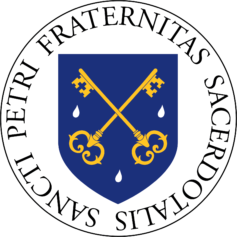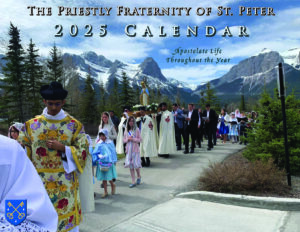See What Comes Up
by Fr. Gerard Saguto, FSSP
We all have blind spots about ourselves and situations we may be in, and the realization of such things can be quite the exercise in humility.
For those who are fans of the old Far Side comic strip by Gary Larson, part of his brilliance was his ability to capture how humanity is prone to missing the obvious. In one such frame, a building that houses a ladder company is on fire, and as the employees look out from a third story window, the caption has them wishing how they could find a way to climb down. We laughed hard.
One reason for our personal blind spots and missing the obvious can be a lack of courage to face ourselves. Another is the fallen-nature blindness that affects us all and inclines us to take for granted things that we are used to: be it a spouse, family, friends, health, employment, position, or other things.
 As this unfolds, we lose sight of the individual trees that make up the forest. We start to get sloppy; our fallen tendency to search out the path of least resistance becomes more insistent. If left unchecked, we find ourselves in a rut where it seems we are just spinning the wheels; meaning about things that should be important gets confused, or even lost, and a frustration with life begins to set in.
As this unfolds, we lose sight of the individual trees that make up the forest. We start to get sloppy; our fallen tendency to search out the path of least resistance becomes more insistent. If left unchecked, we find ourselves in a rut where it seems we are just spinning the wheels; meaning about things that should be important gets confused, or even lost, and a frustration with life begins to set in.
However, there are a couple of ways to regain perspective and renew vigor.
It can happen from a negative event; that is, when someone or something becomes threatened in such a way that forces us to look at it with the attention it deserves. The illness of a spouse or child, the moving away of a close friend, the loss of a job or health can all be real motivating factors to help us realize the genuine value of something. The heartfelt acknowledgment of potential loss is a sure-fire way of checking contempt and correcting things. The benefit and usefulness of suffering is evident in such instances, at least in hindsight.
Positively, perspective and vigor can also be reclaimed by personal initiative and vigilance to make sure we do not get into ruts with the things that are supposed to be most important, that we are mindful of the obvious in such matters (kind of ironic when you hear it said that way). Hence the old adage that “an ounce of prevention is worth a pound of cure.”
Such initiatives and efforts need not be tiresome, but the sacrifice that goes into being thoughtful and present has a cost, be it in personal time or convenience. Even more so, things that are most important also have an uncanny ability to expose our personal limits and insecurities, which we find threatening as they leave us open to criticism, and so engaging them carries its own risks. But with any worthwhile risk comes the true opportunity for growth: a gaining of self-knowledge, peace, perspective, and competency.
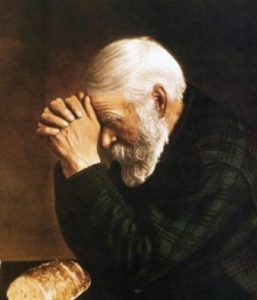 Our Holy Faith often falls victim to being taken for granted. While a routine and discipline are important (assuming these has been achieved in some measure), mindless routine and lack of discipline prey upon the vitality we, deep down, sense the Faith should inspire. Sure, we believe in what the Church proposes for us to believe because it comes from Jesus Christ, but that needs to penetrate more deeply and be pulled in from its ethereal orbit around our souls.
Our Holy Faith often falls victim to being taken for granted. While a routine and discipline are important (assuming these has been achieved in some measure), mindless routine and lack of discipline prey upon the vitality we, deep down, sense the Faith should inspire. Sure, we believe in what the Church proposes for us to believe because it comes from Jesus Christ, but that needs to penetrate more deeply and be pulled in from its ethereal orbit around our souls.
With Advent upon us, the evident threats posed from the secular world compel us all to make concerted efforts to keep “Jesus as the reason for the season.”
The threats certainly have increased in intensity in recent years; even the lukewarm Christian can sense this and perhaps feels the need to join in the resistance and push back. To be a contributing part of this effort requires that our Lord possesses a key place in our hearts. But how to do so when belief seems so uncertain or dark?
This side of eternity, there will always be a certain obscurity to Faith because God wishes that we walk in trust of Him; He wants to lead us because our sanctification is His work with our cooperation. Without Me, you can do nothing (Jn. 15:5).
Adam and Eve tried to steal a glimpse of something they should not have, to put themselves in a position of control they could not have, and that is why faith was so insisted upon by our Lord throughout the Gospel. He is in control, and our fidelity in things both small and large is what obtains for us the supernatural insights into His very life and designs. We wait for the coming of the Son of God-made-Man, the focal point of all history, the only God there is, born to hang on a Cross and redeem us from our sins.
This cannot become ho-hum, but we know there is always a danger of that, or getting stuck in a rut. So does the Church.
 No wonder then, that at the beginning of the liturgical year the Church employs the imperative Excita – Stir up! in the Mass prayers of Advent. We are Baptized and likely Confirmed; that means that graces come with these two sacraments that put us on a path to meet God, throughout this life, at our judgment, and hopefully face-to-face in heaven for eternity. Baptism and Confirmation have left an “indelible mark” on our souls that can never be erased, courtesy of the Holy Ghost, from which Christ identifies us as citizens of His Kingdom and belonging to Him.
No wonder then, that at the beginning of the liturgical year the Church employs the imperative Excita – Stir up! in the Mass prayers of Advent. We are Baptized and likely Confirmed; that means that graces come with these two sacraments that put us on a path to meet God, throughout this life, at our judgment, and hopefully face-to-face in heaven for eternity. Baptism and Confirmation have left an “indelible mark” on our souls that can never be erased, courtesy of the Holy Ghost, from which Christ identifies us as citizens of His Kingdom and belonging to Him.
If the Holy Ghost impressed them, that means He is always ready to “stir up” their consequences – a renewed and invigored faith, courage to tackle the obstacles that challenge its practice, be it in our own soul or in the world, for the love of God and neighbor in the imitation of Christ.
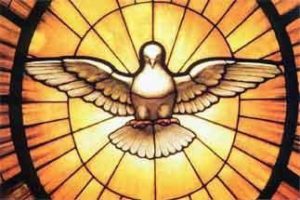 In our troubled times, make it a personal initiative through Advent (and perhaps beyond) to invoke the Holy Ghost daily, that He indeed “stirs up” this treasure-chest of graces we hold within ourselves and our families. Use those words.
In our troubled times, make it a personal initiative through Advent (and perhaps beyond) to invoke the Holy Ghost daily, that He indeed “stirs up” this treasure-chest of graces we hold within ourselves and our families. Use those words.
Unite such an invocation with our Lord’s true presence in the nearest Tabernacle, a most important and “obvious” belief of the Holy Faith. If we know of loved ones who have wandered, ask the same for them, that they begin to sense the “obvious” need for the Church and the Sacraments, particularly Holy Communion and confession. And for conversions we pray for, remember that among the Christian “denominations” there is only one Baptism – it belongs to the Catholic Church – so ask the Holy Ghost to “stir up” in them the courage to see where the blind spots are in their profession of faith.
The glad tidings of Christmas should be obvious to anyone who believes. This is the will of God, your sanctification (1 Thess 4:3).
Light and life to all He brings, throwing light on our blind spots, provided of course that we give the Infant in the Manger the attention He rightfully deserves.
December 2, 2020

Interview with Fr. Thomas Sofatzis, FSSP
Readers of the Missive may be interested in this recent interview with Fr. Thomas Sofatzis on Sacred Music, Beauty, and the Priesthood.
In this special episode of the Parousia Podcast, Phillip Brooks is joined by Fr Thomas Sofatzis FSSP to discuss the sacred Priesthood of Jesus Christ, ordinations in the midst of Covid, the importance of beauty in the liturgy, Church architecture and sacred music.
Fr Sofatzis grew up in Sydney attending his home parish of St Bernadette’s in Clemton Park before discovering the Traditional Latin Mass at the Church of the Maternal Heart of Mary in Lewisham and subsequently joining the Priestly Fraternity of St Peter. He was ordained on the 8th of August 2020, and had only been ordained a month at the time of this recording.
December 1, 2020

The Altar is the Crib
We are now in Advent — a time of watching and waiting.
A weary, exhausted world awaits its redemption. The Magi await a King of Kings. John the Baptist awaits the Messiah. And Our Lady awaits a Child who will be the fulfillment of all of these.
We might be tempted in this time of medical and political uncertainty to place our hopes and expectations in other solutions to the world’s problems.
But as Catholics our hearts’ joy rests instead, as we will soon sing in the carol In Dulci Jubilo, in the presepio. And as St. Alphonsus Liguori has taught us, Christ “is born every day in the Sacrament by means of the priests and the words of consecration; the altar is the crib.”
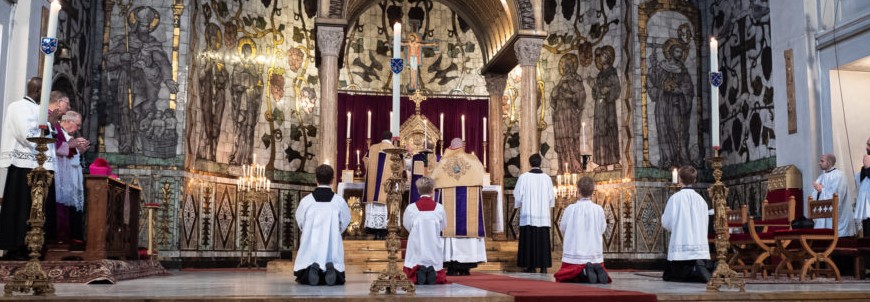 It was in the quiet stillness of Bethlehem, in a manger, away from the halls of power, that the world was redeemed. And that Incarnation continues to be made present in thousands of whispered consecrations over the altars of the world.
It was in the quiet stillness of Bethlehem, in a manger, away from the halls of power, that the world was redeemed. And that Incarnation continues to be made present in thousands of whispered consecrations over the altars of the world.
As we enter this penitential and hopeful season, let us remember that it is the Masses of our priests that truly and really bring our Savior into the world.
With humble thanksgiving and recourse to God, we ask the faithful for their spiritual and financial support this Advent as we strive to increase our Mass times and make Christ’s birth present to all the devout faithful no matter what obstacles may be placed in our way.
Please keep us in your prayers and, if you are able, join us tomorrow, December 1st for our Giving Tuesday campaign to help us meet the sacramental challenges that we face: https://fssp.com/giving-tuesday/
And may the Christ child, who continues to feed us from the crib, continue to draw us all closer to the life of the Holy Trinity in heaven.
November 30, 2020

Home Base
by Fr. Gerard Saguto, FSSP.
With Thanksgiving Day, many are (or were, depending on where you live) looking forward to getting together at home and spending time with family and friends.
The thought of home is something that is written into the heart of every human being; while often times it brings to mind a physical house or location, it goes deeper.
 In fact, there seems to be an unspoken standard for comparison about what constitutes a home: home is supposed to be a place of security, stability, and safety, a place where one found love and learned about life, was educated and allowed to mature, so as to engage and contribute well to the larger world outside it, and remained always a place one can return to for a needed respite. While every home has its own mix of dysfunction, the anger and frustration displayed by those raised in more dysfunctional ones reveals this innate sense of what was to be expected.
In fact, there seems to be an unspoken standard for comparison about what constitutes a home: home is supposed to be a place of security, stability, and safety, a place where one found love and learned about life, was educated and allowed to mature, so as to engage and contribute well to the larger world outside it, and remained always a place one can return to for a needed respite. While every home has its own mix of dysfunction, the anger and frustration displayed by those raised in more dysfunctional ones reveals this innate sense of what was to be expected.
A home then is not a sum of commands or rules given by a father or mother. Rather, a home is ultimately an interaction between personalities that are supposed to be loving each other – spouses, parents, children, siblings, grandparents. Rules or commands should be in play, and they need to be, but these are not what are supposed to define the home. The rules and commands originated with a person.
A few years ago, there was a large national media initiative to reach out to lapsed Catholics called Catholics Come Home. While it had varied levels of success, it was an interesting approach, because this reality of the Catholic Church as a home often escapes Catholics when they consider what the Church actually is.
With only a vague sense of her origins and history, and an anemic experience with the institutional aspect of the Church, many Catholics indeed tend to view the Church as a sum of commands and rules, imposing a morality that they find outdated or even impossible. Finding little support, the faith infused at Baptism is stifled and choked by the thorns of the world, and it becomes easy to drift away. What they ultimately have lacked, though, is a real sense of contact, intrigue, and love with a Person. Where to begin?
But we preach Christ and Him crucified. (1 Cor:23)
Is the Man on the Cross just a man?
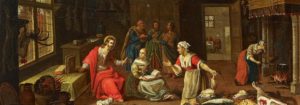
The Church is a home, and that is because it begins with a Person, Jesus Christ, true God and true Man. Faith must begin in Him, for faith is a meeting of two personalities – Christ and me.
Who do you say that I am? Christ asks His Apostles. (Mt 16:15) There is only one correct answer to this question, upon which is built the entire deposit of Faith.
As our Lord taught, governed, and sanctified by His physical Body that He took of our Lady overshadowed by the Holy Ghost, so He continues to do now with His Mystical Body, the Church, overshadowed by the Holy Ghost on Pentecost. There is no doctrine, no moral apart from Him who declares Himself to the be the Truth.
Nothing is credible in the Church apart from Christ who lives in it with us; if we do not believe Christ is God, then we never believe in the truths that flow from that and have had tremendous impact on us – the Holy Trinity, the Holy Eucharist, the Resurrection, the forgiveness of sins.
Therefore, the Church cannot be considered as something that stands between me and Christ, as so often is alleged.
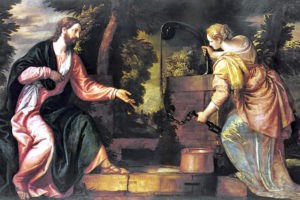 The Church is Christ, in her visible human element and invisible divine element, living through the ages in such a way as to be a place of dogmatic and moral security as a house built on rock, and where one understands how to love and live from the Person who is Life itself.
The Church is Christ, in her visible human element and invisible divine element, living through the ages in such a way as to be a place of dogmatic and moral security as a house built on rock, and where one understands how to love and live from the Person who is Life itself.
This means that love is the basis of being a member of the Church, as it is supposed to be the basis of being a member of a home.
We have been baptized into Christ’s death, the greatest act of love ever displayed and graciously made available to all. As dysfunctional as the Church can be in her human element – and she is – it is perfect love of Christ Crucified, our “Eternal Contemporary” as Ven. Fulton Sheen coins Him, living in the Church that seeks to unite her members and remain the constant inspiration for our holiness and mutual forgiveness.
Falling away from the Church is falling away from love of a Person, a veritable running away from the home Christ built. A Person stands behind the doctrine and morals.
Be convinced that He always leaves His runaways with a key to get back into the house. And a real hand with a hole in it stands ready to open the door.
That is something to be most thankful for.
November 25, 2020

Signs and Churches
by Fr. William Rock, FSSP
It would be difficult to overstate the important role which signs hold in Catholicism.
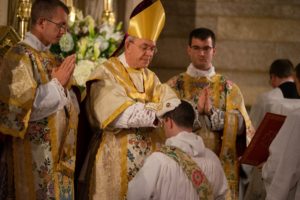 They are, in fact, everywhere and are foundational to the Catholic system. The Sacraments are sacred signs instituted by Christ which confer grace. The Sacraments and Sacramentals are signs which declare the Church’s faith (see S.T. III, q. 61, a. 4, c). The words of Scripture and the words and gestures of the Liturgical rites are all signs. St. Thomas teaches that the Sacramental Characters of Baptism and Orders empower their possessors to receive and confer sacred signs respectively (see S.T. III, q. 63, especially, a. 2, c and a. 4, ad. 3).
They are, in fact, everywhere and are foundational to the Catholic system. The Sacraments are sacred signs instituted by Christ which confer grace. The Sacraments and Sacramentals are signs which declare the Church’s faith (see S.T. III, q. 61, a. 4, c). The words of Scripture and the words and gestures of the Liturgical rites are all signs. St. Thomas teaches that the Sacramental Characters of Baptism and Orders empower their possessors to receive and confer sacred signs respectively (see S.T. III, q. 63, especially, a. 2, c and a. 4, ad. 3).
But the question may be rightly asked: what exactly is a sign?
According to Words of Wisdom – A Philosophical Dictionary for the Perennial Tradition, a sign is “a linguistic or other type of thing used to represent something else” (s.v. “Sign”). To put it more simply, a sign points to something beyond itself.
Some signs are natural. For example, smoke is a sign: it points to fire. Other signs are produced by intelligences, and these are called conventional signs. A traffic light is such a sign: a man-made sign, with the different colored lights pointing to, indicating, what actions the drivers should take.
Words are signs, as they point to ideas and realities beyond just an arrangement of shapes or sounds. The word “dog,” whether written or spoken, expresses, or points to, the idea one has of dog in the intellect and/or the dog which exists in reality.
God Himself also makes use of signs.
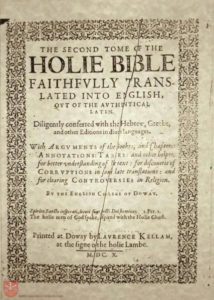 Christ instituted the Sacraments. Sacred Scripture, written under the inspiration of God, is a collection of signs. By way of example, the word “ark” written on the page points to the ark which really existed and was built by Noah. But the use of signs in Sacred Scripture goes deeper than this. As St. Thomas wrote, “the author of Holy Writ is God, in whose power it is to signify His meaning, not by words only (as man also can do), but also by things themselves” (S.T. I, q. 1, a. 10).
Christ instituted the Sacraments. Sacred Scripture, written under the inspiration of God, is a collection of signs. By way of example, the word “ark” written on the page points to the ark which really existed and was built by Noah. But the use of signs in Sacred Scripture goes deeper than this. As St. Thomas wrote, “the author of Holy Writ is God, in whose power it is to signify His meaning, not by words only (as man also can do), but also by things themselves” (S.T. I, q. 1, a. 10).
God, as He is the Author of reality, can have the realities expressed by the words of Sacred Scripture be themselves signs of other realities. So, while the word “ark” is a sign for the ark which really existed and was built by Noah, the ark which really existed was itself a sign of – it pointed to and expressed characteristics of – the Church.
As the dedications of several churches has been celebrated liturgically this month (the Dedication of the Archbasilica of Our Holy Savior [Archbasilica of Saint John Lateran] on November 9th and the Dedication of the Basilicas of Sts. Peter and Paul on November 18th), it is worth noting that the Church views these buildings, and all church buildings, as signs.
What do church buildings symbolize? To what are they supposed to point? What do they represent? The Neo-Gallican Preface for the Dedication of a Church expresses the following:
You Who being the giver of all good things, dwellest in this house of prayer which we have built, and sanctifiest the Church, which Thou didst found Thyself, with unceasing work. For this is truly the house of prayer, represented by visible buildings, the temple wherein dwelleth Thy glory, the seat of unchanging truth, the sanctuary of eternal charity.
According to the text, the “visible buildings,” the physical church buildings, represent, point to, are signs of, the Church, the Mystical Body of Christ, the truest “house of prayer…the temple wherein dwelleth Thy glory, the seat of unchanging truth, the sanctuary of eternal charity.” This expresses the mind of the Church, that church buildings – temples as the Liturgy calls them – are signs of the Church herself: Militant, Suffering, and Triumphant.
The same sentiment is expressed in the Postcommunion (In anniversario Dedicationis) from the Mass of a Dedication of a Church. In this prayer, the Church prays:
O God, Who from living and chosen stones dost prepare an eternal dwelling-place for Thy majesty; assist Thy suppliant people, that Thy Church, whilst benefitting by material enlargement, may also expand by spiritual increase.
From the text of prayer, it is clear that what is being prayed for is not the material building, but the Church herself, being built up by “living and chosen stones,” the Christian faithful.
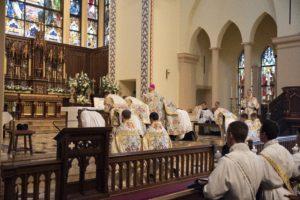 It seems safe to hold, then, that this implies that the stones and other material used to build a church building are signs of these “living and chosen stones” which build up the Church, thus again indicating that the church building is a sign of the Church. The ending of the prayer also indicates that the Church, as expressed by her Liturgy, recognizes a relationship of sign and signified between the church building and the Church herself, for the prayer asks that just as there is a “material enlargement,” an increase in the sign, may the reality to which the sign points, the Church herself, “also expand by spiritual increase.”
It seems safe to hold, then, that this implies that the stones and other material used to build a church building are signs of these “living and chosen stones” which build up the Church, thus again indicating that the church building is a sign of the Church. The ending of the prayer also indicates that the Church, as expressed by her Liturgy, recognizes a relationship of sign and signified between the church building and the Church herself, for the prayer asks that just as there is a “material enlargement,” an increase in the sign, may the reality to which the sign points, the Church herself, “also expand by spiritual increase.”
As it is the Mind of the Church, expressed in the above Preface and Postcommunion, that church buildings are signs of the Church herself, they should be so designed and decorated so as to express this symbolism.
The style of the architecture, even in a simple church, should lift the mind from the day-to-day to things which are spiritual, supernatural, and eternal. Images of the Angels and Saints in the church building are signs of members of the Church Triumphant inhabiting it. It is unfortunate then, when church buildings are built or re-designed in such a way that minimizes this expression.
Reducing the church building to a utilitarian minimum, with an exaggerated focus on the church building being a worship space for the gathered community, serves to obscure the pointing of the church building to the Church herself.
The same is true when the signs used in the Sacraments and Sacramentals are reduced to a bare minimum. Continual exposure to such minimalism can only serve to numb the faithful’s receptively to the signs traditionally use in the Church’s liturgies. Such a numbness not only hinders believers from fully entering into the Church’s practices, but also alienates them from the mindset of their Catholic forbearers.
While it might be true that learning the meanings behind some of the signs used by the Church may take some effort, various resources are available to aid the faithful. Let us then, dear readers, commit ourselves to being immersed in the Church’s language of signs and to having a truly Catholic understanding of Scripture, the Sacraments, Sacramentals, and, indeed, even church buildings themselves.
Fr. William Rock, FSSP was ordained in the fall of 2019 and is currently Assistant Pastor at Mater Misericordiae parish in Phoenix, AZ.
November 23, 2020

Stop Staring at Light Bulbs
by Fr. Gerard Saguto, FSSP.
We all know how frustrating things can get with the varied degrees of shortcomings displayed by the human element of the Church.
Temptations to question the veracity of the Church may begin to slowly foment in the hearts and minds of those trying to walk the straight and narrow path that leads to eternal life.
Prudentially, while there is some responsibility to keep ourselves reasonably informed about what may or may not be going on, there are limits to this, and especially if we find the news upsetting our inner peace and adversely affecting the performance of the duties of our states in life, one of the four principal means to salvation (something perhaps for a later post).
Keeping a cool head in times of trial and stress is important, and a contributing component to that is to keep an objectivity about things.

After all, staring at a lit light bulb long enough makes everything else around it dark, and we lose needed circumspection – and joy.
In remedy to this, these wise words of Frank Sheed from Christ in Eclipse written in 1978 and one of his last books, and indeed one that is highly recommended to be read, should be taken to heart (all emphases original).
Excerpt from Frank Sheed’s Christ in Eclipse
“In the criticisms uttered by many who do not get around to leaving the Church, there is the same failure to see Christ as the whole point.
“So much in her daily running they find depressing – the sermons, they say, take no one deeper into the reality of God or man; this priest or that cares for nothing but money, the sick neglected, the old rejected; the hierarchy know nothing of the emotional or intellectual problems that are eating away at the vitality of their people’s faith; the Curia is simply a bureaucracy, using every trick to hold on to its power; as for the pope …. It adds up to the ‘Institutional Church,’ with so many wondering if their spiritual integrity will permit them to remain in her.
“I am meeting this wherever I go. I have fallen into the way of reminding the objector that Institutional Israel, the Chosen People, as the Prophets show it, was even worse than the harshest critics think the Catholic Church: yet it never occurred to the holiest of Jews to leave it.
“They knew that however evilly the administration behaved, Israel was still the people of God. So with the Church: an administration is necessary if the Church is to function, but Christ is the whole point of the functioning.
“We are not baptized into the hierarchy, do not receive the cardinals sacramentally, will not spend eternity in the beatific vision of the pope.
 “St. John Fisher could say in a public sermon: ‘If the Pope will not reform the Curia, God will.’ A couple of years later he laid his head on Henry VIII’s block for papal supremacy, followed to the same block by Thomas More, who had spent his youth under the Borgia pope, Alexander VI; lived his manhood under the Medici pope, Leo X; and died for papal supremacy under Clement VII, as time-serving a pope as Rome had had.
“St. John Fisher could say in a public sermon: ‘If the Pope will not reform the Curia, God will.’ A couple of years later he laid his head on Henry VIII’s block for papal supremacy, followed to the same block by Thomas More, who had spent his youth under the Borgia pope, Alexander VI; lived his manhood under the Medici pope, Leo X; and died for papal supremacy under Clement VII, as time-serving a pope as Rome had had.
“Christ is the point. I myself admire the present pope, Paul VI; but even if I criticized him as harshly as some do, even if a successor proved to be as bad as some of those who have gone before, even if I sometimes find the Church as I have to live in her a pain in the neck, I should still say that nothing a pope could do or say would make me wish to leave the Church, though I might well wish that he would.
“Israel, through its best periods as through its worst, preserved the truth of God’s Oneness in a world swarming with gods, and the sense of God’s Majesty in a world sick with its own pride. So with the Church.
“Under the worst administration – say as bad as John XII’s a thousand years ago – we could still learn Christ’s truth, receive His life in the sacraments, be in union with Him to the limit of our willingness. In awareness of Christ, I can know the Church as His Mystical Body. And we must not make our judgments by the neck’s sensitivity to pain!”
November 20, 2020

Sacrifice for Starving Souls
Join us for Giving Tuesday: https://fssp.com/giving-tuesday/ .
November 18, 2020

Giving Tuesday: December 1, 2020
If you’re like us at FSSP North American headquarters, you’ve grown weary of reading about the “uncertain times” in which we live. Most people seem to assume that this uncertainty stems from forces beyond our control. But in fact, the unsettled state of our society is self-inflicted.
 For years, those in power have told us that it is not only permissible but laudable to be uncertain about gender identity, the sanctity of human life, the indissolubility of marriage, and even the very concept of absolute truth. Hence the current implosion.
For years, those in power have told us that it is not only permissible but laudable to be uncertain about gender identity, the sanctity of human life, the indissolubility of marriage, and even the very concept of absolute truth. Hence the current implosion.
Sadly, this implosion is evident even within Holy Mother Church. High-ranking churchmen have boldly proclaimed that we can no longer be certain about listing abortion first among the injustices in society, about restricting Holy Orders to men, or about the immorality of praying to false idols in a consecrated building.
Thanks be to God, then, for our traditional Catholic faith, through which we can be certain of a great many things.
We can be certain that Jesus Christ is truly present—Body, Blood, Soul, and Divinity—in the Holy Eucharist. We can be certain that the holy priest on the other side of the grill is acting in persona Christi when he says, “I absolve you in the name of the Father, and of the Son, and of the Holy Ghost.” We can be certain that each of us will receive a particular judgment—and that we had better spend each day preparing ourselves to meet Our Lord.
Help the FSSP Spread Truth in Our Troubled World
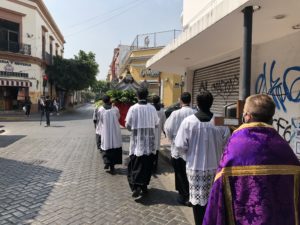 The best response to our “uncertain” times is to make the certainty of traditional Catholicism available to as many souls as possible. Unfortunately, the coronavirus lockdown has forced numerous restrictions on FSSP apostolates across North America. Some parishes still must limit their congregation sizes, and in a few places civil governments and dioceses are returning to lockdowns once again.
The best response to our “uncertain” times is to make the certainty of traditional Catholicism available to as many souls as possible. Unfortunately, the coronavirus lockdown has forced numerous restrictions on FSSP apostolates across North America. Some parishes still must limit their congregation sizes, and in a few places civil governments and dioceses are returning to lockdowns once again.
Rather than let their parishioners starve spiritually, our FSSP priests have responded with heroic generosity. Some parishes are now offering as many as 10 Masses on Sundays. Some offer five Masses each weekday. Many have extended their hours for confession.
But even FSSP priests have their limits.
Canon law limits each priest to celebrating two Masses on weekdays and three Masses on Sundays. Thus, an FSSP apostolate with three priests can only offer nine Sunday Masses. This is not always enough for an apostolate that’s attracting hundreds of new parishioners who have grown frustrated by the restrictions of their previous parishes and seek a fuller spiritual life.
This year on Giving Tuesday, the FSSP aims to raise $90,000 to help us meet the pastoral and sacramental challenges of the times.
Please Make Your Gift on December 1
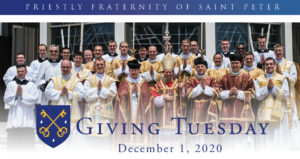 Giving Tuesday is an annual online event in which nonprofits of all kinds seek to raise money on the Tuesday after Thanksgiving. This year’s Giving Tuesday will be on December 1, 2020.
Giving Tuesday is an annual online event in which nonprofits of all kinds seek to raise money on the Tuesday after Thanksgiving. This year’s Giving Tuesday will be on December 1, 2020.
Many organizations have raised astounding sums on Giving Tuesday—and the FSSP is no exception. Last year, we aimed to raise $60,000. Thanks to your generosity, we raised over $70,000.
This year we have set an even more ambitious goal of $90,000 that will enable us to expand our apostolic work forming new priests and ensuring the Sacrifice of the Mass continues across the country.
Our priests are multiplying Mass times, are extending Confessions, and will be there at your bedside when needed.
That’s why we’re asking you to join us on Giving Tuesday. Making your donation of any size takes just seconds online.
 As a special thanks to all who support us, we’ll enter donors into a drawing to win one of several FSSP-branded gifts, and all gifts above $500 will receive an FSSP liturgical calendar. We’ll be sending email, social media, and Missive reminders leading up to Giving Tuesday.
As a special thanks to all who support us, we’ll enter donors into a drawing to win one of several FSSP-branded gifts, and all gifts above $500 will receive an FSSP liturgical calendar. We’ll be sending email, social media, and Missive reminders leading up to Giving Tuesday.
Thank you for your unfailing support of the Priestly Fraternity of St. Peter. With your help, we will continue to bring the fullness of Christ into the emptiness of the world.
Of this you can be certain.
November 16, 2020

Merchandise for Missions
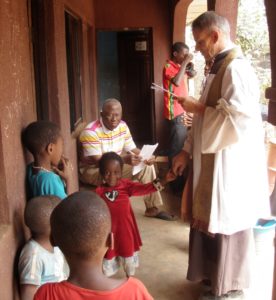
Make a difference and support Mission Tradition with a purchase from our online store Merchandise for Missions.
All profits will directly benefit the FSSP Missions, and you can use these items as a conversation-starter to share your faith with family, friends, and strangers.
The Priestly Fraternity of St. Peter: Merchandise for Missions
For more information on our mission work in Nigeria, Mexico, Colombia, etc., see our Mission Tradition website at: https://www.missiontradition.us/
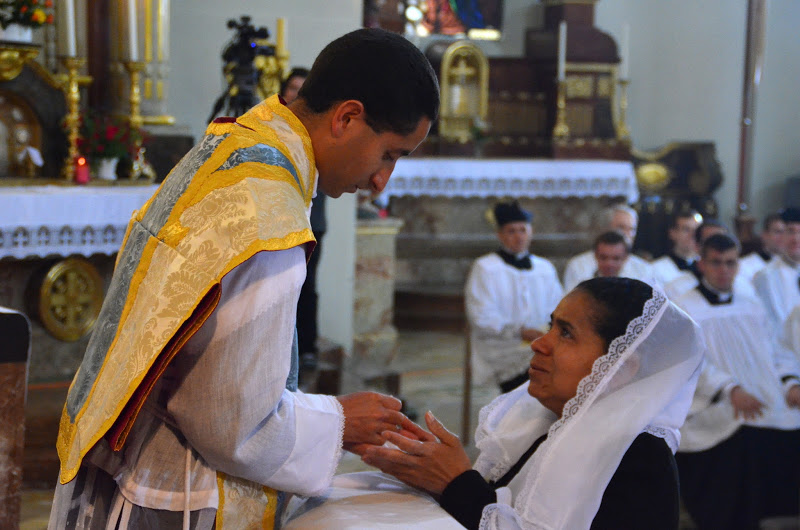
November 13, 2020

Be Prepared for that Last Step: Extreme Unction continued
What is the purpose of Holy Anointing?
When should we receive it? Why do we need it? And why does hell hate it?
First of all, there has been a bit of abuse of this Sacrament in our modern time; although its use has been broadened a bit in relation to a person’s proximity to death due to an illness, it still is only for maladies that have real life-threatening potential. Because an illness may be painful, it does not mean it is life-threatening.
Therefore, anointing someone for a cold, cough, fever, stomachache, ear infection, arthritis or the like is outside the scope of the Sacrament; the ritual actually has special blessings for sick adults and children for cases when Holy Anointing should not be administered. Therefore, there needs to be a clear cause-and-effect relationship between the illness and death.
So if one is diagnosed, for instance, with an untreatable type of cancer, or if a needed treatment of some potentially lethal disease is rather aggressive and has a significant failure rate, then the Sacrament can be received, even at the onset of the sickness, and it can be repeated if the condition worsens considerably; most especially when death seems near. However, as there can be gray areas in these regards, and considering that what is life-threatening for one person may not be another, it is always good to consult a knowledgeable priest in the case of doubt or confusion.
What, then, are the effects of the Sacrament and why are they so profitable to our salvation and perhaps, as death is near, so necessary?
The anointing with consecrated olive oil well represents the effect it signifies: an increase of grace and the comfort that comes with it.
 Christ instituted this Sacrament to give the soul strength and comfort at the time of its likely greatest difficulty and danger. In the presence of the priest who alone can administer it, the Sacrament is ordered to inspire trust and confidence in God, providing the soul with assurance of help against temptation and the fear of dying. It disposes the dying soul to be patient and resigned, to accept the kind of death God wills and understand it as most beneficial to its salvation, while soothing the affections for the loved ones it will soon depart.
Christ instituted this Sacrament to give the soul strength and comfort at the time of its likely greatest difficulty and danger. In the presence of the priest who alone can administer it, the Sacrament is ordered to inspire trust and confidence in God, providing the soul with assurance of help against temptation and the fear of dying. It disposes the dying soul to be patient and resigned, to accept the kind of death God wills and understand it as most beneficial to its salvation, while soothing the affections for the loved ones it will soon depart.
Along with this, the soul finds special strength against the devil, who now endeavors to make his greatest effort to ruin it: as the whole kitchen sink can get thrown into the mix, the soul is assisted to combat the strong temptations that may set in, to repel sadness, despair, and fear of God’s judgment, together with newfound strength to combat the ruling sin of one’s life.
As if this were not enough, Holy Anointing also remits sin and some of its temporal punishment, which is why, incidentally, the sacrament is not to be given to infants or children under the age of reason.
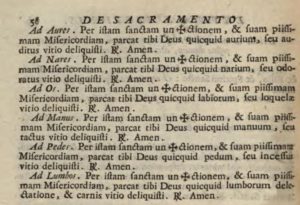 In the older and venerable Roman rite, whenever possible, all the senses are anointed separately, and this is because each sense is a gateway to temptation and sin. While doing so, the priest implores God through the anointing and His mercy to forgive whatsoever sins one may have committed through that particular sense – hearing, speech, touch, and so on.
In the older and venerable Roman rite, whenever possible, all the senses are anointed separately, and this is because each sense is a gateway to temptation and sin. While doing so, the priest implores God through the anointing and His mercy to forgive whatsoever sins one may have committed through that particular sense – hearing, speech, touch, and so on.
Although the Sacrament is primarily concerned with the remission of venial sin, it also can remit mortal sin, provided the person is unable to confess and has at least imperfect contrition. This is why it is so important to contact a priest while the sick person is still lucid and in a good mental state, so as to give him the chance to make a sincere confession before being anointed.
Although the priest must do all he can to dispose a person to repentance, obviously there are greater signs of this when a person is conscious. Furthermore, although it may happen that a good-willed Catholic calls the priest to the bedside of a non-Catholic relative who is unconscious, if the dying person never gave any manifest intent to convert, the sacrament cannot be administered. (While on the subject, if you are wondering what a priest does when he comes across an accident and is unable to determine whether the person is Catholic or not – which is usually the case – he can anoint the person, but he does so conditionally.)
With the forgiveness of sins, Holy Anointing also removes what is called the “remains of sin,” that is, a certain weakness and laziness of soul, whereby new strength is gained to repel a distaste for spiritual things and some of our evil inclinations.
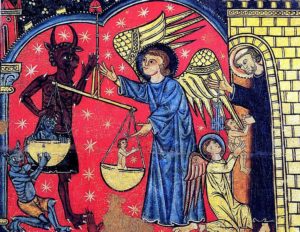 The entire Sacrament, therefore, is all about preparing the soul to meet Christ, its Savior and Judge, which is why everyday we ought to pray for a holy death; that is, a death in a state of grace, fortified by the Sacraments so as to deny the devil his greatest prize. Remember that resigning ourselves to and embracing the type of death God wills is so meritorious that it actually has the potential to remit all the temporal punishment that we have incurred through life due to sin; we can actually bypass Purgatory, because it is a most perfect way in a certain regard to unite ourselves with the Cross of our Lord and His own Death.
The entire Sacrament, therefore, is all about preparing the soul to meet Christ, its Savior and Judge, which is why everyday we ought to pray for a holy death; that is, a death in a state of grace, fortified by the Sacraments so as to deny the devil his greatest prize. Remember that resigning ourselves to and embracing the type of death God wills is so meritorious that it actually has the potential to remit all the temporal punishment that we have incurred through life due to sin; we can actually bypass Purgatory, because it is a most perfect way in a certain regard to unite ourselves with the Cross of our Lord and His own Death.
Holy Anointing is about making that happen; the devil knows that, and that is why he tempts us in so many ways to put off the Sacrament until it is too late because of the strength it gives us to do just that.
Practically then, make sure those closest to you know to call a priest in the event of a life-threatening condition; keep the number handy, and perhaps even carry one of those cards in your wallet or purse that identifies you as a Catholic and that a priest is to be notified in the event of a serious accident. But even in the case of sudden death, call the priest anyway, as a warm body can still be anointed conditionally.
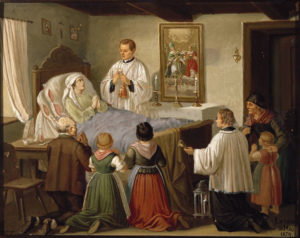 All the Sacraments of the Church are about life, and all the Sacraments of the Church emphasize the God-given dignity of man. Holy Anointing points out that our lives are sacred even unto death, that there is value and meaning in anything we may endure or suffer in a life given over to God. The presence of a priest at the bedside of a dying man or woman bears testimony to God’s commitment to us to the very last moment of our earthly sojourn, and shows how God desires to make use of everything for His glory and our salvation – and the devil’s humiliation.
All the Sacraments of the Church are about life, and all the Sacraments of the Church emphasize the God-given dignity of man. Holy Anointing points out that our lives are sacred even unto death, that there is value and meaning in anything we may endure or suffer in a life given over to God. The presence of a priest at the bedside of a dying man or woman bears testimony to God’s commitment to us to the very last moment of our earthly sojourn, and shows how God desires to make use of everything for His glory and our salvation – and the devil’s humiliation.
We must foster an insistence and stubbornness within ourselves, parents, siblings, spouses, and children over the reception of Extreme Unction when it is our time; let it be the exclamation point on a life-long preparation for death.
Again, Christ gives us what we need: a sacrament to sweeten the pain of separation, a sacrament to help us die in the arms of God, a sacrament to help us take the most important step in life from this world into the next, and a sacrament that should be what God intends it to be – a source of comfort, strength, grace, and health, where we emerge the victor in the fight.





